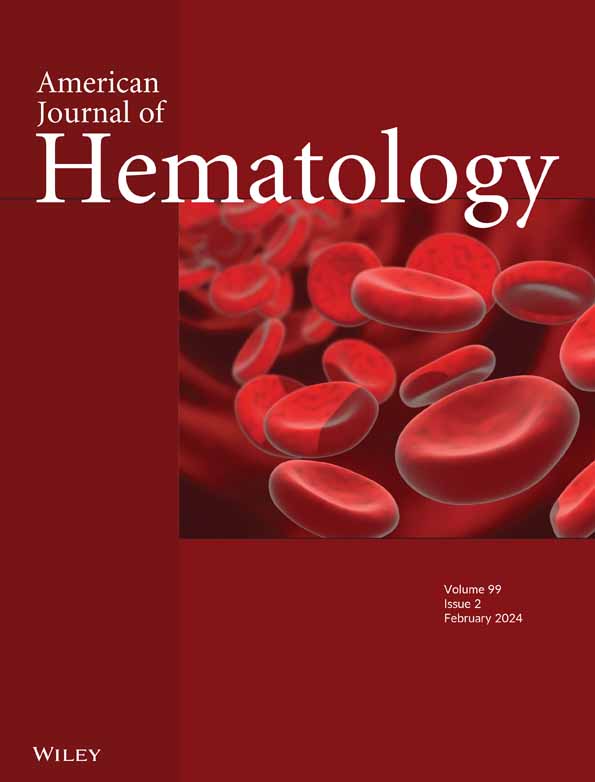遗传性出血性疾病患者静脉血栓栓塞的患病率和危险因素:一项ATHNdataset研究
IF 9.9
1区 医学
Q1 HEMATOLOGY
引用次数: 0
摘要
据推测,患有遗传性出血性疾病的人可以预防静脉血栓栓塞(VTE)的风险,但缺乏关于该人群中静脉血栓栓塞率和危险因素的支持数据。本研究的目的是确定一组遗传性出血性疾病患者的静脉血栓栓塞率和危险因素。本研究使用美国血栓和止血网络(ATHN)数据集。研究对象为有静脉血栓栓塞记录的遗传性出血性疾病患者。收集有关出血性疾病、人口统计学、静脉血栓栓塞类型和合并症的数据。采用标准描述性分析对数据进行汇总,并采用逻辑回归分析确定危险因素。我们在ATHNdataset中共确定了49151例遗传性出血性疾病患者。总共观察到388例新的静脉血栓栓塞(0.8%;95% CI: 0.7, 0.9)。静脉血栓栓塞诊断的中位年龄为27.5岁(IQR: 15.3-48.2)。凝血酶原缺乏组血栓栓塞率最高,为19%,血友病A和B组相对较低,为0.4%。在血友病队列中,静脉血栓栓塞率在使用抑制剂的患者中较高(p < 0.001)。静脉血栓栓塞复发率为4.9% (n = 19/388)。在多变量分析中,黑人(OR = 1.90)、中心静脉线(CVL) (OR = 2.76)和心脏合并症(OR = 16.86)被确定为静脉血栓栓塞的危险因素。总之,我们的研究结果表明,患有遗传性出血性疾病的人并不能预防静脉血栓栓塞。个体因素如心脏合并症和CVL的存在可增加血栓形成前的风险。本文章由计算机程序翻译,如有差异,请以英文原文为准。
Prevalence and Risk Factors for Venous Thromboembolism in People With Inherited Bleeding Disorders: An ATHNdataset Study.
It is presumed that people with inherited bleeding disorders are protected against the risk of venous thromboembolism (VTE) but the supporting data regarding rates and risk factors for VTE in this population are lacking. The objectives of this study were to determine the VTE rates and risk factors in a cohort of individuals with inherited bleeding disorders. American Thrombosis and Hemostasis Network (ATHN) dataset was utilized for this study. The population of interest was individuals with an inherited bleeding disorder with a documented VTE. Data were collected regarding their bleeding disorder, demographics, type of VTE, and comorbidities. Data were summarized using standard descriptive analyses, and logistic regression analyses were used to identify risk factors. We identified a total of 49,151 individuals with inherited bleeding disorders in the ATHNdataset. A total of 388 new VTE (0.8%; 95% CI: 0.7, 0.9) were observed. Median age at VTE diagnosis was 27.5 years (IQR: 15.3-48.2). VTE rates were highest in prothrombin deficiency at 19% and relatively lower in hemophilia A and B at 0.4%. Within the hemophilia cohort, rates of VTE were higher in those with inhibitors (p < 0.001). The VTE recurrence rate was 4.9% (n = 19/388). On multivariable analysis, Black race (OR = 1.90), central venous line (CVL) (OR = 2.76), and cardiac comorbidity (OR = 16.86) were identified as risk factors for VTE. In summary, our results demonstrate that people with inherited bleeding disorders are not protected against VTE. Individual factors such as cardiac comorbidity and the presence of a CVL can increase the prothrombotic risk.
求助全文
通过发布文献求助,成功后即可免费获取论文全文。
去求助
来源期刊
CiteScore
15.70
自引率
3.90%
发文量
363
审稿时长
3-6 weeks
期刊介绍:
The American Journal of Hematology offers extensive coverage of experimental and clinical aspects of blood diseases in humans and animal models. The journal publishes original contributions in both non-malignant and malignant hematological diseases, encompassing clinical and basic studies in areas such as hemostasis, thrombosis, immunology, blood banking, and stem cell biology. Clinical translational reports highlighting innovative therapeutic approaches for the diagnosis and treatment of hematological diseases are actively encouraged.The American Journal of Hematology features regular original laboratory and clinical research articles, brief research reports, critical reviews, images in hematology, as well as letters and correspondence.

 求助内容:
求助内容: 应助结果提醒方式:
应助结果提醒方式:


